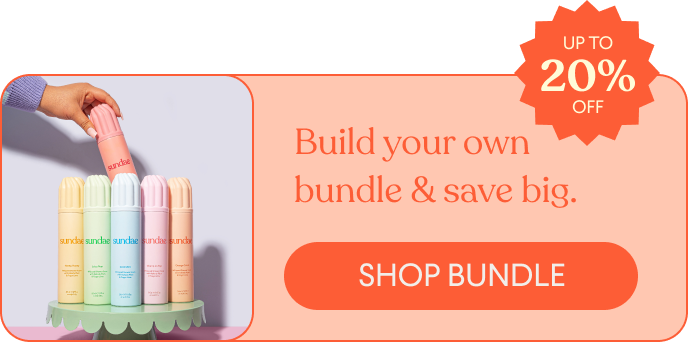The Harmful Ingredients Hiding in Your SPF

There’s a long list of ingredients that – *sigh* – are still being used in skincare and cosmetics, despite growing evidence that they may be potential hormone disruptors or harmful to coral reefs and marine life. From parabens to oxybenzone, discover what ingredients to avoid in sunscreen, so your skin can have a hot (and safe) girl summer, spring, autumn and winter! (Because, as we know, SPF is an all-year-round event.)
Common Harmful Ingredients in SPF
While over in the U.S., the Food and Drug Administration (FDA) has published a list of harmful ingredients, some still make their way into products. (Naughty!) This includes Oxybenzone and Avobenzone (both benzophenones), Homosalate (a hormone disruptor), Octinoxate (also known as octyl methoxycinnamate, another hormone and endocrine disruptor), as well as Octocrylene and Octisalate. Okay – these are some big words that – let’s be real – are a little tricky to pronounce… and even trickier to understand. Don’t stress – here’s a simplified deep dive into some of the main troublemakers.
Oxybenzone
A chemical compound, Oxybenzone is the active ingredient in many over-the-counter sunscreens and other personal care and skincare products. As a UV-ray blocker, it’s highly effective in slowing the absorption of harmful UVA and UVB rays by human skin. But – and here’s the kicker – it also has the worst reputation when it comes to damaging reefs. Luckily, many skincare and bodycare brands (including us – duh!) are choosing to create oxybenzone-free sunscreens that are safer for ocean life, the reef, and us humans, too. But, if you see it being all sneaky in that large list of ingredients? Bye, b*tch. (Sorry not sorry.)
Avobenzone
Avobenzone is an organic molecule and an oil-soluble ingredient used in many sunscreen products to absorb the full spectrum of UVA rays. As of 2021, the FDA announced that they do not support avobenzone as being generally recognised as safe and effective (aka GRASE) citing the need for additional safety data. We’ll stick to avocado, thanks. 🥑
👉 More on this topic: Do Lips Get Sunburned? Everything You Need to Know About Lip SPF
Octinoxate
Octinoxate is a chemical ingredient that’s used to absorb UVB rays from the sun. Scientists aren’t sure if octinoxate is harmful to humans because there’s not enough research to prove its safety. The few studies that do exist suggest it has little effect on humans. But, scientists do know that octinoxate harms marine ecosystems. (Water treatment plants can’t easily remove chemical sunscreens, so octinoxate ends up in rivers and oceans.) Because of these findings, some regulatory bodies have banned sunscreens that contain it.
❤️ You'll Love: Can Sunscreen Be Your Acne-Prone Skin's Best Friend?
Parabens and phthalates
Ah, the p-words. Parabens and phthalates sure don’t sound as scary as the other scientific-sounding ingredients, but they’re hot on the no-no list. The main concern is that scientific studies suggest that parabens can disrupt hormones in the body and potentially harm fertility and reproductive organs, affect birth outcomes (which is why there is specific skincare advice during pregnancy), and increase the risk of cancer.
Watch out for: Ethylparaben, butylparaben, isobutylparaben, isopropylparaben, methylparaben and propylparaben. (And phthalates, too.)
Sundae’s SPF Pick
Oh finally, we’re at the good part! Great news, people. Our entire suncare range is free from oxybenzone, octinoxate, parabens, phthalates and all that other annoying stuff.
🧴Now that you know what SPF ingredients to banish from your shopping cart, it’s time to check out our Suncare Range.
Happy Sundae x
Always read the label and follow the directions for use. Sunscreen is only one part of sun protection. Avoid prolonged high-risk sun exposure. Re-apply frequently.
Written By: Lizzie Waley (Sundae Co-Founder & Body Care Enthusiast) | LinkedIn
Fact Checked: Charnnie Frimpong (Sundae Content Marketing Manager) | Linkedin

